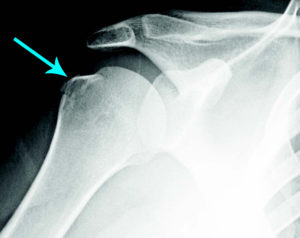Published on
Differential Diagnosis
- Shoulder dislocation
- Distal clavicle fracture
- Avulsion of the greater tuberosity
- Osteolytic lesion
- Scapular fracture
Diagnosis
This patient sustained an avulsion of the greater tuberosity. The x-ray shows oblique lucency undermining greater tuberosity of the humerus, with cortical irregularity.
Learnings
- An avulsion of the greater tuberosity is sometimes called a “hidden fracture” because it usually presents as an undisplaced fracture, which often does not show up on x-rays
- This injury is often associated with tear of the supraspinatus tendon
- When minimally displaced, treatment is often successful without surgery
Pearls for Initial Management and Considerations for Transfer
- Shoulder trauma should be imaged in the urgent care, looking for:
- Dislocation
- Fracture of the humerus, clavicle, and scapula
- Acromioclavicular (AC) separation
- Abnormalities of associated structures such as rib fractures or pneumothorax
- A dislocation can be reduced in the urgent care, per provider experience.
- Indications for transfer include:
- Patients with severe pain
- Diagnostic uncertainty
- Dislocation unable to be reduced
A 38-Year-Old Woman with Shoulder Pain
1 2

